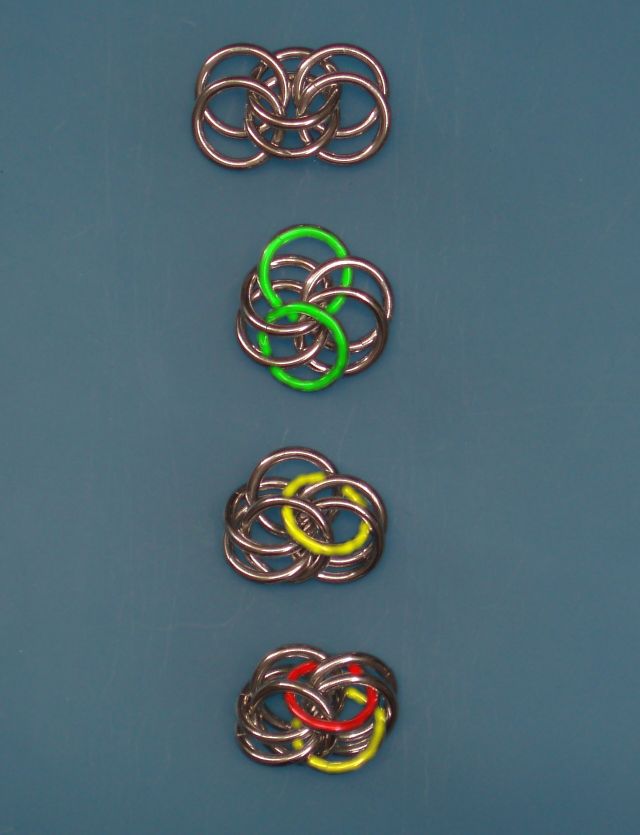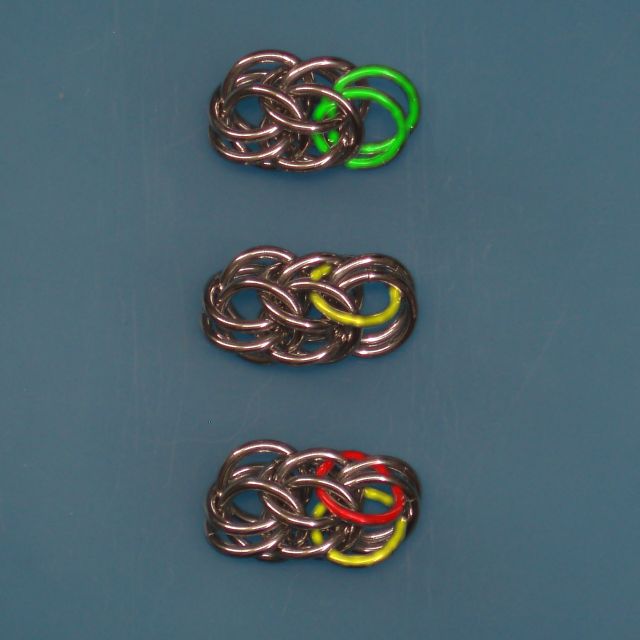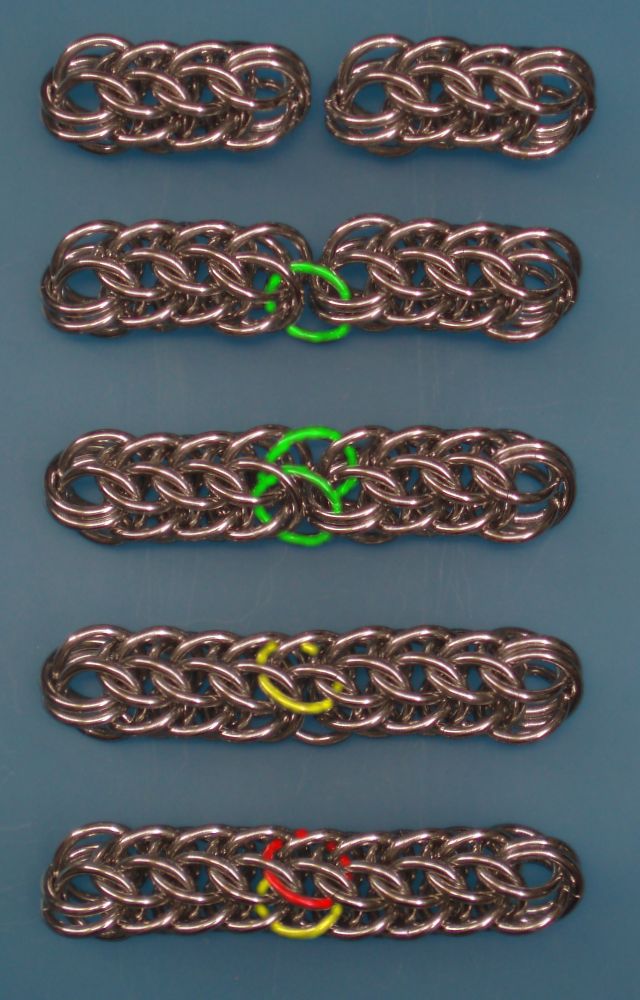To Tutorial Home
Full Persian 6in1 - how I do it
This weave is one of the basic standard weaves, and so should be taught to every new aspiring mailler as one of the very first weaves. It works with rings above an AR of around 4.9 - there is principally no upper AR limit. The 'sweet spot' AR is imho in the 5.5 region, and above an AR of around 6 it becomes imho a bit too loose. I propose to learn it with BA rings 1.6mm (~16swg) coiled on 5/16" or 8mm mandrel - these differ only minimally and result in an AR in the 5.1 to 5.3 ballpark. But if you have e.g. 16swg 3/8" ones (AR~6.3) around, this should not hinder you to use these. If you want it a bit smaller, 1.2mm (18swg) coiled on 6mm or 1/4" mandrel are fine. This tutorial's sample chains were made from 1.6*8.0mm rings.
But now let's start - this tutorial is divided in three parts - the creation of the basic starter cell, extension of an existing chain, and joining of two segments or one chain into a continuous loop.
Section one - how to get started.
1) Prepare a 2-2-2 chain segment.
2) Flip the leftmost ring pair back (rings marked green here). Some maillers like to add a ring in Byzantine weaving-style, and/or a tie wire to stabilize - this can be needed, or at least make life easier, if one works with smaller rings. This method is shown in an alternative tutorial image, that I made some time ago, and maybe suits you better.
3) Add a ring through all four vertical rings, stacked above and NOT sandwiched between the horizontal ring pair (new ring is marked yellow here).
4) Twist chain by 180 degrees, and add the final ring to the segment, in the same manner as in previous step (new ring marked red).
- Part 1 done - you have a stable Full Persian starter cell in your hands.

Section two - lengthening a FP chain.
1) Add a pair of rings (here marked green), sandwiched between and 'through the butt crack' of the last 'vertical' ring pair, and through the last horizontal ring pair, similar to weaving Byzantine/Boxchain. If needed, twist your chain segment by 90 degrees first, to get it into the start orientation.
2) Add a ring through all four vertical rings, stacked above and NOT sandwiched between the horizontal ring pair (marked yellow). You may note that this is the very same as step 3 of the starter cell.
3) And as the similarity continues: Twist chain by 180 degrees, and add the final ring to the segment, in the same manner as in previous step (ring marked red).
- 'Rinse and repeat' steps one to three, to build addon FP cells, until needed chain length is reached.

Hint: There is also an alternative weave method, that can come handy if the available workspace is tight, due to a chosen low (near limit) ring AR: Set the 'red' and 'yellow' rings first, before adding the 'green' ones thereafter. Here only caution is needed, that both red and green settle along the outside of the previous ring cell's rings, that are sandwiched by them, before adding the other ring pair.
Section three - join two segments of FP, or close one chain into a seamless continuous loop
1) Arrange the 2 segments in a manner that both have the same 'V grain' direction at the top (and so also both the opposite grain direction at the sides). This is crucial, else a seamless join is impossible. My sample photos show the chains with the last ring pair of the left chain vertical, and the first one of the addon chain horizontal. This makes the joining similar to the starting or lengthening of a FP chain, as shown above in this tutorial.
2) Add (like shown for lengthening step 1, and again marked green) one vertical ring, sandwiched between and 'through the butt' of the last 'vertical' - AND thread it through the horizontal ring pair of the followup chain, WITHOUT intersecting its vertical rings.
3) Again, add a second vertical ring, in the same manner as the previous one. Note, that in the following step the two (here green) rings MUST sandwich the vertical ones of the followup chain, but this position is not yet stable.
4) Arrange the 'green' rings, as just told. This can be a bit difficult, as the ring positions are far from stable, and rings can yet slip out of their supposed-to position. Now add a ring (yellow), as shown in the image, and in a similar manner as lengthening a FP chain. Now you just have to thread this ring also at the proper position, SANDWICHED between the followup chain's horizontal pair, but also stacked above the first (left) one's horizontal pair. So the pattern is followed continuous, and now the vertical rings of the previous steps are finally locked in position.
5) And last, but not least, twist the chain by 180 degrees, and add the final connector ring (red), identical to the last one. Again this is similar to the last set ring of lengthening by a segment. Due to tight work space, this can be very difficult, especially at low ARs. This is normal, I cannot do anything about, but you'll surely manage...

Have fun with Full Persian 6in1 :)
-ZiLi-
To Tutorial Home


